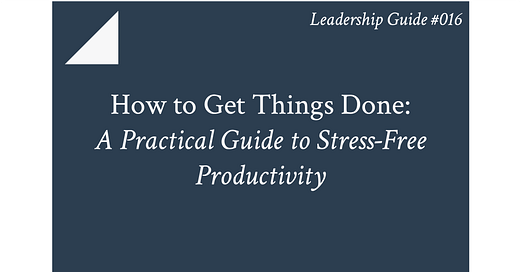How to Get Things Done: A Practical Guide to Stress-Free Productivity [How-To Guide #016]
Based on David Allen’s “Getting Things Done”
👋 Welcome to a 🔒 subscriber-only edition 🔒 of our Leader Guide newsletter. Every Saturday, we provide a practical deep dive into a complex leadership and management issue. (We share our best free content on LinkedIn).
Make #@*% Happen
In our hyperconnected, fast-paced world, the demands on our time and attention seem unending. Emails, meetings, deadlines, and personal obligations all compete for priority, leaving many people feeling overwhelmed or perpetually behind schedule. For those seeking calm in this chaos, David Allen’s Getting Things Done: The Art of Stress-Free Productivity (often referred to as GTD) stands out as a powerful, enduring framework.
Allen’s core argument is simple yet transformative: your mind is a terrible place to store unorganised “to-dos.” Keeping tasks in your head leads to stress and mental clutter, undermining creativity and clarity. Instead, Allen prescribes a system that captures every commitment, idea, and obligation in a trusted external system, freeing your mind to think strategically rather than struggle under a vague sense of unfinished business. Once externalised, tasks can be processed, organised, and reviewed systematically—enabling you to decide confidently what to do (or not do) at any given moment.
Where other productivity methods emphasise rigid scheduling or time-blocking, GTD focuses on building flexible workflows that accommodate life’s unpredictability. Allen’s approach resonates with busy professionals, freelancers, students, and parents alike because it’s not tied to a particular tool, app, or job context. Instead, the system rests on universal principles—capture everything that matters, clarify what you actually need to do, keep tasks in contexts that make sense, and review them regularly.
This guide translates the GTD system into clear steps, from understanding its foundational concepts to overcoming common barriers like procrastination, perfectionism, or logistical roadblocks (e.g., messy emails or scattered notes). We will explore the tangible benefits of adopting GTD in both personal and professional settings, including reduced stress, improved focus, and greater trust in your own commitments. Next, we’ll map out the entire method, highlighting how to capture, clarify, organise, reflect, and engage with tasks effectively. Along the way, we’ll suggest modern tools and technologies that can facilitate your GTD journey, plus tips on measuring and sustaining progress.
If you’re ready to trade anxiety for a sense of flow, and endless juggling for purposeful action, David Allen’s GTD system might be the productivity reboot you’ve been seeking. Let’s dive in.
Capture, Clarify, Organise, Reflect, and Engage
David Allen’s Getting Things Done system rests upon several key ideas that work together to alleviate mental stress and boost efficiency:
1. The Mind as a Creative Tool, Not a Storage Unit
Allen contends that our brains are built for generating ideas, not for holding onto them. When we rely on memory alone to manage tasks, we risk mental overload. Consequently, we feel anxious about forgetting something vital. GTD addresses this by urging us to move tasks out of our minds and into a reliable “external brain,” such as a notebook, app, or list.
2. The Core Workflow
At its heart, GTD follows a five-step process:
Capture: Collect everything that has your attention—ideas, to-dos, meeting notes—into a single, trusted place.
Clarify: Decide what each item actually represents: Is it actionable? If so, what’s the very next step? If not, is it trash, reference material, or something to incubate for later?
Organise: Put action items in logical categories—such as “Phone Calls,” “Errands,” “Projects”—and set up a calendar for items with fixed due dates.
Reflect: Regularly review all your lists and calendars to keep the system current. This especially includes the Weekly Review, a crucial habit to maintain clarity.
Engage: Choose what to do in the moment based on context, available time, energy, and priority.
3. Next Actions vs. Projects
Another hallmark of Allen’s approach is distinguishing between “Projects” (any outcome requiring multiple steps) and the specific “Next Actions” that move those projects forward. Many people procrastinate because tasks remain nebulous and overwhelming. By always identifying a tangible next action—for example, “Email Jane about the design mockup” instead of “Work on project”—you create momentum and reduce uncertainty.
4. Contextual Task Lists
Rather than keep one massive to-do list, GTD sorts items by context. For instance, you might have a “@Computer” list for things that need a computer, “@Home” for chores, and “@Errands” for tasks that require being out and about. This approach respects the reality that you can only do certain tasks in certain settings.
5. The Weekly Review as a Keystone
A pivotal element in GTD is the Weekly Review, where you revisit your entire system: inboxes, lists, calendars, and upcoming commitments. This ritual ensures your system remains accurate, revealing stale tasks and letting you plan the next week with a fresh perspective.
By adhering to these core concepts—capturing everything, clarifying next actions, organising tasks by context, reflecting often, and engaging confidently—you shift from reactive firefighting to methodical progress, all while keeping stress at bay.
Why GTD Pays Off for Individuals and Organisations
The GTD method isn’t merely a personal productivity hack; it carries broader implications for how teams and entire organisations function. When you and those around you operate with clarity and reduced stress, the ripple effects include better collaboration, faster decision-making, and a more innovative culture. Here’s why:
1. Enhanced Individual Performance
By capturing every commitment in a systematic fashion, employees spend less time mentally juggling tasks. This frees cognitive energy for strategic thinking and problem-solving, rather than losing focus to the swirl of “Did I remember everything?” anxieties. As people gain control of their personal workloads, overall output and quality often rise.
Keep reading with a 7-day free trial
Subscribe to Leaders of the People to keep reading this post and get 7 days of free access to the full post archives.


